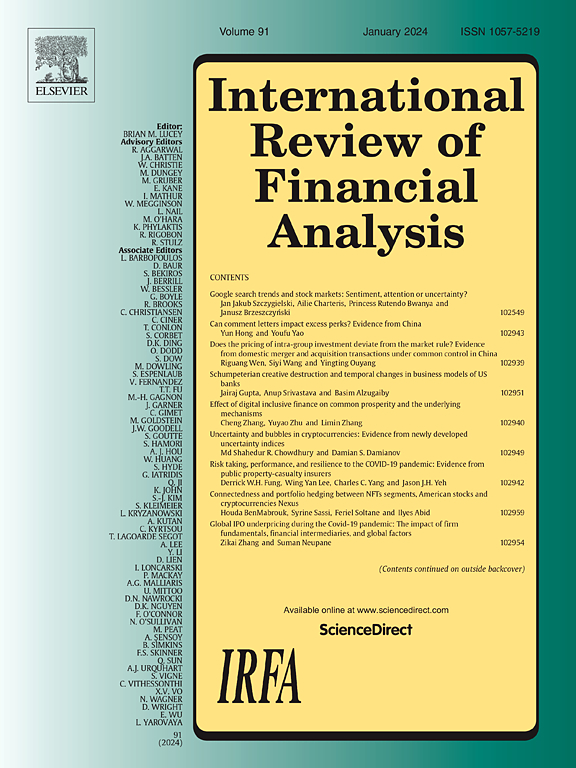Digital economy and urban green transformation
IF 7.5
1区 经济学
Q1 BUSINESS, FINANCE
引用次数: 0
Abstract
This study examines the impact of the digital economy on green transformation, drawing on provincial-level panel data from China spanning 2012–2023. Using advanced econometric techniques, including threshold regression, spatial Durbin models, and mediating effect analyses, the research provides robust evidence of the digital economy's role in reducing carbon intensity. Results reveal significant direct effects, where digitalization enhances energy efficiency and optimizes production processes. Additionally, indirect effects emerge through the development of information and technology and industrial restructuring, further amplifying environmental benefits. A nonlinear relationship is observed, with the most substantial environmental advantages occurring at moderate levels of digitalization, followed by diminishing returns at higher levels. Moreover, notable spatial spillover effects are observed, demonstrating that advancements in one region's digital economy positively influence green transformation in neighboring areas. These findings reflect the digital economy's crucial role in advancing sustainability goals and offer actionable insights for policymakers. To maximize environmental benefits, regions with lower levels of digitalization should prioritize investments in digital infrastructure and technology adoption, whereas more advanced regions should focus on enhancing energy efficiency and integrating green technologies. The study also highlights the importance of inter-regional collaboration in leveraging spatial spillover effects to drive collective progress toward green transformation. By integrating direct, mediating, nonlinear, and spatial dimensions into a unified analytical framework, this research advances theoretical understanding and provides practical recommendations for harnessing digitalization as a tool for sustainable development.
数字经济与城市绿色转型
本研究利用2012-2023年中国省级面板数据,考察了数字经济对绿色转型的影响。该研究利用阈值回归、空间德宾模型和中介效应分析等先进的计量经济学技术,为数字经济在降低碳强度方面的作用提供了强有力的证据。结果显示了显著的直接影响,数字化提高了能源效率并优化了生产过程。此外,信息技术的发展和产业结构调整产生了间接影响,进一步扩大了环境效益。观察到一种非线性关系,在中等水平的数字化中出现最显著的环境优势,其次是更高水平的收益递减。此外,研究还发现了显著的空间溢出效应,表明一个地区的数字经济发展对邻近地区的绿色转型具有正向影响。这些发现反映了数字经济在推进可持续发展目标方面的关键作用,并为政策制定者提供了可行的见解。为实现环境效益最大化,数字化水平较低的地区应优先投资于数字化基础设施和技术应用,而数字化水平较高的地区应侧重于提高能效和整合绿色技术。该研究还强调了区域间合作在利用空间溢出效应推动绿色转型的集体进步方面的重要性。通过将直接、中介、非线性和空间维度整合到统一的分析框架中,本研究推进了理论认识,并为利用数字化作为可持续发展的工具提供了实践建议。
本文章由计算机程序翻译,如有差异,请以英文原文为准。
求助全文
约1分钟内获得全文
求助全文
来源期刊

International Review of Financial Analysis
BUSINESS, FINANCE-
CiteScore
10.30
自引率
9.80%
发文量
366
期刊介绍:
The International Review of Financial Analysis (IRFA) is an impartial refereed journal designed to serve as a platform for high-quality financial research. It welcomes a diverse range of financial research topics and maintains an unbiased selection process. While not limited to U.S.-centric subjects, IRFA, as its title suggests, is open to valuable research contributions from around the world.
 求助内容:
求助内容: 应助结果提醒方式:
应助结果提醒方式:


